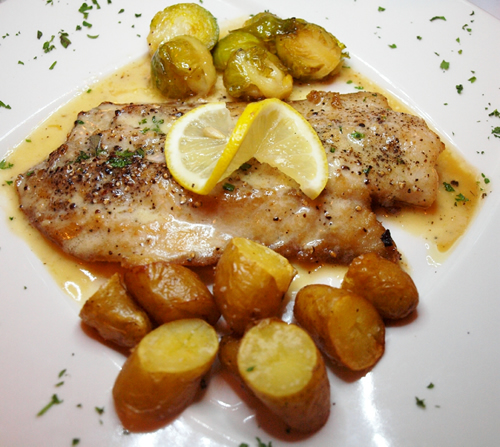
Black Drum
Drum was once despised, almost to the point of being considered trash fish. Then redfish disappeared from markets and restaurants, and suddenly we were eating quite a bit of drumfish. And found that it wasn't so bad after all.
In fact, drum and redfish are close cousins and similar in many ways. One of those is important: you don't want a big one. It was the fishing of the big redfish by people who didn't know any better (and needed to supply the market for blackened redfish 20 years ago) that resulted in its being taken off the commercial fisherman's list.
 The right size drum is sometimes called "puppy drum." This is a two-to-four pounder, and it's a nice fish indeed. It works for most uses to which we put speckled trout (another relative), and it's often brought in to sub for specks when the season is over (as it is right now). Drum is about the same white-with-a-tinge-of-gray color, with flakes of approximately the same size and texture.
The right size drum is sometimes called "puppy drum." This is a two-to-four pounder, and it's a nice fish indeed. It works for most uses to which we put speckled trout (another relative), and it's often brought in to sub for specks when the season is over (as it is right now). Drum is about the same white-with-a-tinge-of-gray color, with flakes of approximately the same size and texture.
Drum grills nicely--better than speckled trout does. It also is a very good fish for broiling. In fact, I'm trying right now to think of a cooking method for which puppy drum isn't especially good, and all I'm coming up with is sushi. (Parasites in members of the drum family make it unsuitable for that purpose, although I have seen it now and then at sushi bars.)
One of the best dishes I ever tasted involving drumfish is the one they do at Drago's under the name "drumfish Tommy," and elsewhere as "drumfish on the half shell." The fish goes onto the grill with skin and scales facing the fire. The top is brushed with garlic and herb butter, and it's left there until done, without turning. The skin gets black and crisp, insulating the fillet from overcooking and lending a sort of steamed effect.
Drum is also the only fish of its kind that's still legally available to commercial fishermen in quantities that make fishing for it a viable proposition. It's caught on long "trotlines," which lend themselves to commercial fishing. The populations are stable and the resource is strong.